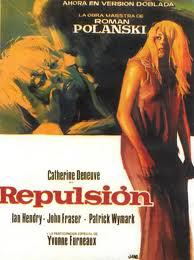
REPULSION (1965)
Section of the cinematic cemetery: Repressed sexual desire, of both the masculine and feminine kind. Scary.
Cause of (premature) death: When it comes to his art and real life, Roman Polanski earns international headlines with both. Released a touch more than a decade before real life pulled ahead slightly in notoriety--Polanski's "incident" in 1977 that caused the director to flee the U.S. (and a jail sentence) for a newfound filmmaking career in France (he even won the Oscar for Best Picture in 2002 for The Pianist, but didn't attend the ceremony, for obvious reasons)-- Repulsion remains his harrowing testament to a vulnerable, volatile creature's slippery descent into madness.
But the drama unfolding around him hardly stained the success of his cinematic pursuits--his oeuvre spans equally dark meditations: Rosemary's Baby, Chinatown and most recently, The Ghost Writer--and Repulsion quietly simmers as the essence of his brilliance, where self-loathing and obsessive introversion violently turns on itself, and of course, on others. If you're alive and a woman, you've seen it. Or you should, now.
What its tombstone would read: A painfully demure Belgian manicurist (Catherine Deneuve) lives in London with her sexually indulgent sister (Yvonne Furneaux) and equally despises the persistent advances of pursuers following her home and the men responsible for her sister's elated howls all night long. The close-ups of Carole's icy but distant eyes, nervous twitches and frail, waif-like figure incited cameraman Gil Taylor to famously proclaim, "I hate doing this to a beautiful woman."
Why it should be revived: A retro incarnation of the classic Lady Macbeth appearance masking reality ploy: Deneuve perfectly encapsulates the innocent flower--men can't help being captivated by her delicate beauty-- but her serpentine inclination inevitably surfaces (at one point, she hacks one unlucky admirer to death), all with a hauntingly calm demeanor. Polanski captures the carnal desire Carole wrestles with like a demon, as she fends off lusty men in real life while succumbing to their pursuits in her fantasies. Freud would have a field day.
The film moves at a glacial place and heightens the sounds and mind tricks inherent to persistent isolation: the ticking of a clock, water dripping from a faucet, and clicking of heels against the pavement amplify Carole's festering, unrelenting madness. Carole curiously floats from her job to her apartment like an insipid ghost of herself and hardly voices a complete sentence throughout the film; trouble is when she temporarily comes back into herself and unleashes the wrath of everything she's hitherto carried around silently. And you know what they say about the quiet ones.

